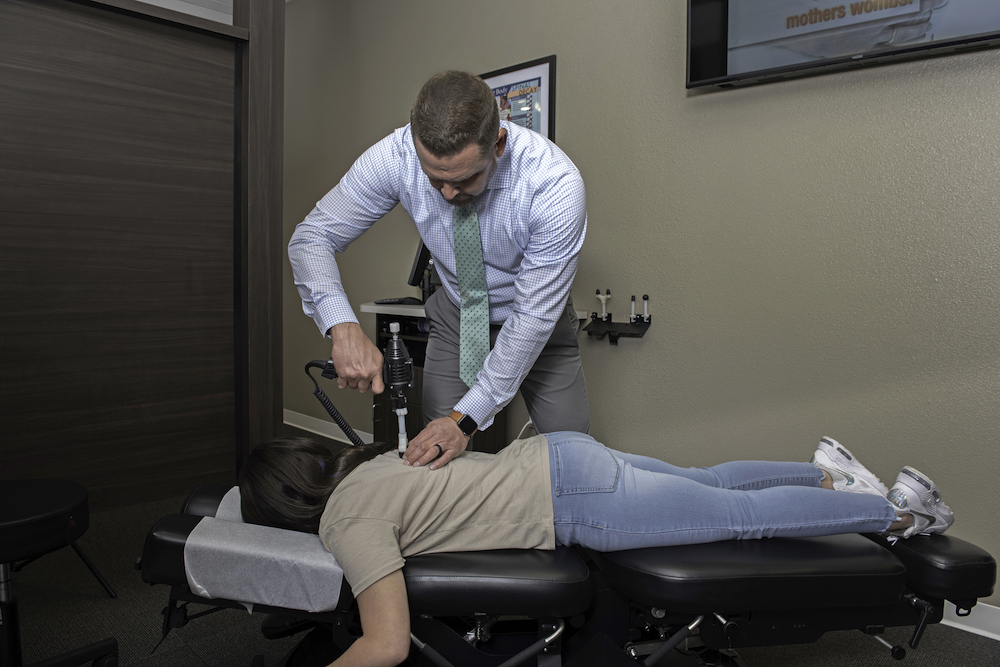Acute or Chronic Lower Back Pain? How to Know and What You Can Do for Relief
5 min read

The spine is amazingly complex and gives us flexibility, strength, and support. But, if you have an injury, overwork your body, or if you’re just getting older, lower back pain can become hard to manage. For a lot of people, back pain is caused by a disc problem, a joint problem or irritated nerves. It can also be muscle-related which is typically short-term or called “acute” back pain. If you let lower back pain continue without treating it properly, it can become a lingering problem that is considered “chronic.”
Learning about the causes of low back pain can help you avoid some of it. And, for those things that are simply caused by age, you’ll be able to identify it sooner so you can get help from a chiropractor or other healthcare professional.
Strains, Sprains and Lower Back Pain
Strains and sprains can occur when you lift a heavy object, twist your spine while lifting or moving, or have a fall or injury that puts too much pressure on your spine. It can also be caused by a lifetime of poor posture. A strain is caused when a muscle is stretched too far and tears. A sprain is caused when a ligament is overstretched and torn. The symptoms and treatment for both injuries are the same. A chiropractor can help by realigning your spine, relaxing the back muscles and helping you to heal quicker.
Lower Back Pain Caused by Disc Issues
There are two primary categories of lower back pain: acute and chronic. Acute pain is caused by an injury, and once the injury is healed then the pain stops. However, chronic pain can be linked to a past injury or a condition that is developing over time that does not seem to get better with treatment and rest. Back pain is classified as chronic pain if it lasts longer than six months.
Acute Spinal Disc Issues
Herniated discs
The discs in your spine are filled with a jelly-like substance, surrounded by a strong outer layer. A herniated disc means that the jelly has broken through the outer layer and is irritating nearby nerves or causing inflammation. A bulging disc is a bit different because the disc hasn’t ruptured yet, but it can still cause some lower back discomfort, especially when bending or twisting.
Compression fracture
This type of fracture occurs when a vertebra collapses in on itself, causing sudden pain. Usually caused by the fragile bones that characterize osteoporosis, this is another disease that is more common in older people.
Sciatica
Sciatica is a term used to describe symptoms caused by another back condition. It can be caused by irritation, inflammation, or compression of the sciatic nerve, the largest nerve in the body. The sciatic nerve is the union of five nerve roots in the lower spine. It extends from the buttocks, down the back of the thighs, to the heels and feet. Sciatic pain is usually only felt on one side of your body.
Sciatica can be caused by several issues:
- A compression fracture
- The physical force from a fall or injury, stenosis
- A herniated disc, or instability caused by one vertebra slipping over the one below it (spondylolisthesis)
- A defect in one or more vertebrae (spondylolysis)
- The dislocation of vertebrae.
Tailbone Pain
The tailbone, called the coccyx, is the small bone at the end of your spine. Persistent pain in this area can be caused by a fall, dislocation, or even sitting too much. The pain can feel like a bad bruise, and the pain can be severe, especially when standing up. Walking can lessen the pain while sitting makes it worse. Tailbone pain is five times more common in women than men. Women often experience it during pregnancy or after childbirth. It is also common in people who are overweight.
Chronic Spinal Disc Conditions
These types of conditions affecting the spine and causing lower back pain are typically a result of aging and deterioration of the spinal disks, joints and/or a narrowing of the spinal column. While there is not a lot you can do to prevent this, you can treat chronic lower back pain so that you’re able to stay active.
Osteoarthritis of the spine / Degenerative disc disease
This type of arthritis, also referred to as degenerative disc disease, is one of the most common causes of lower back pain as we age. It’s caused by wear and tear and can occur when the joints' and discs' protective coating wears down, causing stiffness or pain in the back or neck. Weakness or numbness in the legs can also occur. The pain is a result of inflammation, stenosis, and/or instability. It is more common in older people and people who are overweight. This problem slowly gets worse and can affect any disc or facet joint in the lower back.
Degenerative spondylolisthesis
This degenerative condition is more common in women and older people. As facet joints age, they begin to deteriorate, allowing them to flex too much. When this happens, one vertebra can slip over an adjacent one. Pain results from the compression of the nerves. It can also cause aching in one or both legs and lower back pain. Many people find it uncomfortable to stand or walk for even a short period of time. An injury or fracture can also cause it.
Facet joint dysfunction
Behind each of the discs in your lower back are two facet joints, which permit movement in your lower back. They have cartilage between the bones and are surrounded by ligaments. They can become irritated and painful when you have other low back injuries or strain.
Sacroiliac joint dysfunction
The sacroiliac joint connects the bone (sacrum) to each side of your pelvis. This joint's primary function is to absorb shocks and the natural tension between the upper and lower body. It can become inflamed with too much or too little activity, according to spine-health.com. About 30% of back pain originates from the sacroiliac joint.
Spinal Stenosis
Stenosis means narrowing, and when it happens in the spine, the constricted nerves can cause terrible pain. The narrowing can happen at one or more places in the back. Stenosis starts with pain in the legs or leg cramps, especially with activity. It can progress to constant or severe pain, tingling, numbness, or weakness in the legs, making it difficult to walk.
One way to know if you could have spinal stenosis is if walking normally – with good posture and back straight – is painful, but leaning forward onto something like a shopping cart or walker is less painful. Stenosis occurs most frequently in older people.
Chiropractic Treatments for Lower Back Pain
If you’re experiencing any of these painful back conditions, please consider chiropractic treatment as a way to relieve your pain and prevent more pain in the future. Village Chiropractic in The Woodlands focuses on relieving your pain and improving your health with state-of-the-art chiropractic techniques and therapies such as spinal decompression called Back-on-Trac, cold laser therapy, spinal alignment, and massage therapy.
We are committed to reducing your pain and increasing your ability to move using non-surgical methods. Request an appointment today at our office in The Woodlands to discuss your options for lower back pain relief.





